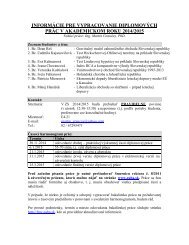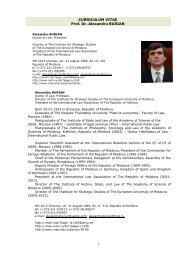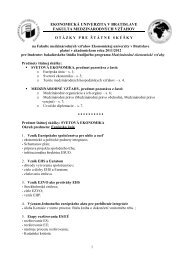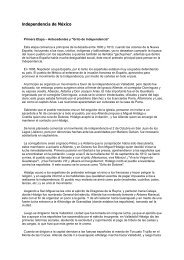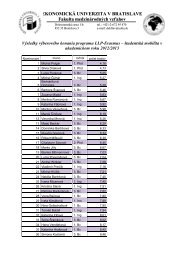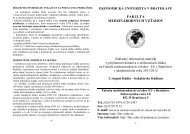investments into properties – see table 1. JPY appreciation could be seen in a significant, butonly temporary decrease in surplus of the trade balance. Unemployment also developedfavourably, inflation slightly grew.1.2 Bubble disruption and transition of the economy into recessionIn 1989 the BOJ increased the discount rate from 2.5% to 4.25% and in 1990 even to6%. The central bank took this step from fear of potential inflationary pressures caused byincreased money supply and because of continuous yen devaluation. While in 1988 prices ofconsumer goods grew by 0.7%, in 1989 it was already by 2.3% and in 1990 by 3.1% – see table1. Monetary control was tightened and the amount of money which banks were allowed toborrow against mortgages in the form of property was limited.Tightening of monetary policy led to a dramatic decrease in asset prices. The stockexchange index Nikkei 225 Average slumped by 44% by1992 compared to 1989 and land priceindexes experienced a similar slump, even though with a certain delay. Immediate impact of thedecrease in asset prices were substantial capital losses – in cumulative expression according tothe OECD in 1990-1996 they reached approximately JPY 967 trillion, i.e. twice the one-yearJapanese GDP. Households carried more than 44% of overall capital losses, non-financialinstitutions 34%. 9The bubble disrupted and the economy slumped into recession during which, however,absolute decrease in current or real GDP was not experienced. In 1990 the growth in real GDPwas still recorded at 5.2%, but already in 1991 the pace started to slow down – see table 1.According to an official statement of the EPA/ESRI the recession started in March 1991 andlasted till October 1993. It was the second longest recession after the recession in 1980-1983. 10Also other developed countries experienced a slowdown in the growth at the beginning of the1990s, many of them also passed through recession, however, from different reasons. Forexample the pace of GDP growth in Germany fell by 1.1% in 1993 and by 0.5% in the USA in1991. 11 In 1991 the BOJ started to cut the discount rate (from 6% down to 1.75% in 1993) toencourage the “strangled” economy. However, the BOJ did not manage to stop the decrease inprivate consumption and gross fixed investments. Japanese government also focused on thesupport of weakened domestic demand. In 1991 the government approved a new 5-year plan for1992-1996. In compliance with the strategy from the 1980s the plan was aimed at improvingthe living standard of Japanese citizens and development of domestic economy and in sametime at a more obliging attitude of Japan to global community. The success, however, was notbig. In the same time three incentive “packages” amounting to JPY 29.9 trillion, i.e. 2-3% ofGDP were adopted in 1992-1993. 12 These fiscal measures should have supported mainly publicinvestments and housing construction and included also reduction in taxes.Thanks to monetary and fiscal measures private investments into properties started togrow slightly, nevertheless private capital investments continued to decline. Only SMEsresponded to the decrease in interest rates, as they are more sensitive to their changes than bigbusinesses. And it is the decrease in fixed investments that is to be blamed for a significantdecrease in the pace of GDP growth. The growth in private consumption also slowed down inthe period in question. 13Although economic dynamics slowed down during the recession, it did not cause anymore substantial problems with unemployment or inflation. Till 1993 the inflation increased9 OECD (1998): OECD Economic Survey – Japan 1997-1998, p. 46.10 ESRI (2011): Guide for Using Diffusion Indexes and Composite Indexes.11 OECD (2001): OECD Economic Outlook No. 7, 2001, p. 205.12 OECD (2000): OECD Economic Survey – Japan 1999-2000, p. 53.13 CAO (2006): Annual Report on the Japanese Economy and Public Finance 2006.MEDZINÁRODNÉ VZŤAHY, 2012, 4 ○ 133
only to 2.5%, i.e. by 0.4 percentage points compared with 1990. As the BOJ intended with itsstrict anti-inflationary packages, the inflation slowed down to 1.2% in 1993 – see table 1.However, the price for this success proved to be too high compared with recession and furtherdecrease in prices. The yen started to appreciate hand in hand with growing real interest rates –this contributed to strengthening deflationary pressures, which caused serious problems to theeconomy in the ensuing period.Due to deepening problems and unclear future of the economy there were significantchanges also on the domestic political scene. In 1993 for the first time since the World War IIthe position of one party, Liberal Democratic Party (LDP) was suppressed. In January 1993Prime Minister Miyazawa was forced to resign due to several corruption scandals andincreasing disagreement among individual fractions in the LDP. Japan New Party won themajority in elections in July 1993. Coalition governments (after 1994 again with the LDP) werenevertheless very fragile and changed very often. There were eight different Prime Ministers inJapan from 1990 to 2000. Domestic political instability and insufficient consensus amongleading parties over the solution to main issues influenced negatively forming of the economicpolicy..2 Recovery of the economy in 1994-1996The recovery phase lasted from November 1993 to May 1997, i.e. 43 months. As thiswas the third longest after-war expansion, 14 the government held the impacts of the precedingserious recession for solved and the phase of stock adjustment for finished. Nevertheless,private investments and consumption were rather instable in this period (particularlyinvestments into real estates) and grew slowly, prices of real estates also continued to decline.Positive development was attributed mainly to ongoing monetary and fiscal incentive measures.However, already in June 1997 the economy fell into another serious recession, which foundexpression even in the decline in the real GDP of 1.8% in 1998 and 0.2% in 1999 – see table 2.Table 2: Japan – Main Economic Indicators, 1994-2000Item 1994 1995 1996 1997 1998 1999 2000GDP in current prices (SNA93) 486,5 493,3 502,6 512,2 503,0 495,2 501,1Nominal growth rates (%) 1,2 1,4 1,9 1,9 -1,8 -1,5 1,2Real growth rates (%) 1,1 1,9 2,6 1,4 -1,8 -0,2 2,9- Private final consumption (%) 2,7 1,8 2,3 0,8 -0,8 1,1 1,1- Residential investment (%) 7,2 -4,8 11,8 -12,0 -14,2 0,1 0,9- Private capital investment (%) -5,7 3,1 1,8 6,6 -5,2 -4,3 7,9Unemployment rate (%) 2,9 3,2 3,4 3,4 4,1 4,7 4,7Consumer price index (CPI, %) 0,7 -0,1 0,1 1,8 0,6 -0,3 -0,7Trade balance (trillion JPY) 14,7 12,3 9,1 12,3 16,0 14,0 12,6Yen exchange rate against U.S.Dollar 107,0 93,0 106,0 120,0 130,0 118,0 106,0Monetary base growth (%, M2+CD) 1 2,1 3,0 3,3 3,1 4,0 3,6 2,1Discount rate (end of year, %) 1,75 0,5 0,5 0,5 0,5 0,5 0,5Note: Shaded areas indicate periods of economic recession.1 The monetary base is defined asthe total of cash in circulation (including cash held by financial institutions) and currentdeposits of financial institutions at the central bank.Source: CAO (2006): Annual Report on The Japanese Economy and Public Finance 2006,(GDP growth rates, inflation, monetary base); Statistics Bureau (2008): Historical Statistics ofJapan (unemployment rate, trade balance, exchange rate); Statistics Bureau (1998): JapanStatistical Yearbook 1998, p. 451 (discount rate); own calculations.14 ESRI (2011): Guide for Using Diffusion Indexes and Composite Indexes.134 ○ MEDZINÁRODNÉ VZŤAHY, 2012, 4
- Page 2 and 3:
Medzinárodné vzťahyVedecký čas
- Page 4 and 5:
ObsahPôvodné vedecké článkyZEN
- Page 6 and 7:
ContentOriginal scientific papersZE
- Page 8 and 9:
P Ô V O D N Ý V E D E C K Ý Č L
- Page 10 and 11:
epublikou a Indickou republikou? Za
- Page 12 and 13:
spočiatku javí iba ako malá sekt
- Page 14 and 15:
Z kulturologického hľadiska tento
- Page 16 and 17:
6. LEHMANNOVÁ, Z. a kol.(2010): Pa
- Page 18 and 19:
krajiny 2 . Zatiaľ čo pri cle pla
- Page 20 and 21:
Textilv ekonomike (P SA /P TA ). 7
- Page 22 and 23:
TextilGraf 3: Účinky subvencií n
- Page 24 and 25:
TextilGraf 4: Účinky subvencií n
- Page 26 and 27:
TextilAnalyzujme teraz rozdiely v d
- Page 28 and 29:
P Ô V O D N Ý V E D E C K Ý Č L
- Page 30 and 31:
dohody, ktorú členský štát uza
- Page 32 and 33:
Na základe návrhu Európskej komi
- Page 34 and 35:
do svojej výlučnej kompetencie, n
- Page 36 and 37:
6. Stanovisko Generálneho advokát
- Page 38 and 39:
a jadrovým programom. Takmer úpln
- Page 40 and 41:
Južná Kórea sa ďalej rozvíjala
- Page 42 and 43:
Napätie medzi obomi štátmi na K
- Page 44 and 45:
Graf 2: Štruktúra tvorby HDP KĽD
- Page 46 and 47:
a luxusného tovaru. Rada bezpečno
- Page 48 and 49:
Osobitnú skupinu ŠEZ tvoria zóny
- Page 50 and 51:
systému na potraviny a iný priemy
- Page 52 and 53:
7. SINGH, L. 2012. India and North
- Page 54 and 55:
D I S K U S I AVÝVOJ MULTILATERÁL
- Page 56 and 57:
chybět příslušné pravomoce k u
- Page 58 and 59:
socialistickou federativní sověts
- Page 60 and 61:
uzavírat bilaterální dohody mezi
- Page 62 and 63:
2 Stěžejní multilaterální obch
- Page 64 and 65:
Pod záštitou UNCTAD byl během ro
- Page 66 and 67:
Celní úmluva ATA karnet pro doča
- Page 68 and 69:
těchto práv jednotlivými státy
- Page 70 and 71:
zejména na nastolování obchodu v
- Page 72 and 73:
33. ORGANISATION FOR ECONOMIC CO-OP
- Page 74 and 75:
D I S K U S I AFAKTORY ROZVOJA A RA
- Page 76 and 77:
tradície a pomerne ľahko sa dost
- Page 78 and 79:
1979 ajatollách Chomejní povolil
- Page 80 and 81:
moslimských krajín - vytvárať n
- Page 82 and 83:
nachádzali v Pakistane, kde v úlo
- Page 84 and 85: jedna skupina argumentuje množstvo
- Page 86 and 87: 28. OLCOTT, M. BRILL (2012). Centra
- Page 88 and 89: planéty Zem, je možné identifiko
- Page 90 and 91: vysokohorských ľadovcov a snehove
- Page 92 and 93: populácie človeka. Len v roku 200
- Page 94 and 95: s tým sú „tiché“ krízy spô
- Page 96 and 97: druhov rastlín alebo globálne ote
- Page 98 and 99: 10. MACGRANAHAN, G., BALK, D. , et
- Page 100 and 101: D I S K U S I ASÚČASNÉ A OČAKÁ
- Page 102 and 103: v Afrike, keďže Maurícius nedisp
- Page 104 and 105: v Baoaré. Krajina patrí medzi naj
- Page 106 and 107: nadmerné znečistenie vody v Čín
- Page 108 and 109: ZÁVERPredkladaný článok analyzu
- Page 110 and 111: D I S K U S I AŠPECIFIKÁ POSTAVEN
- Page 112 and 113: stálym obyvateľstvom, definovaný
- Page 114 and 115: občianstve, ktoré zakladajú prim
- Page 116 and 117: Špecifické a nezameniteľné post
- Page 118 and 119: dochádza v prípadoch exilových v
- Page 120 and 121: P R E H Ľ A DPROBLEM OF EASTERN PA
- Page 122 and 123: countries where the development of
- Page 124 and 125: In the Joint Declaration it was sta
- Page 126 and 127: On the partners’ side we see that
- Page 128 and 129: espect for ordinary citizens of the
- Page 130 and 131: P R E H Ľ A DJAPAN´S LOST DECADE:
- Page 132 and 133: often called a “bubble boom” or
- Page 136 and 137: Ongoing appreciation of the currenc
- Page 138 and 139: usinesses etc.) as well as by long-
- Page 140 and 141: eject it), but he favours the monet
- Page 142 and 143: was bound to take steps. Many other
- Page 144 and 145: preferences. Massive fiscal incetiv
- Page 146 and 147: end of 1998. 55 The crisis also dee
- Page 148 and 149: The central bank also responded to
- Page 150 and 151: 4. CALLEN, T. - McKIBBIN, W. J. (20
- Page 152 and 153: 1, February 2001. [20.3.2008.] Avai
- Page 154 and 155: P R E H Ľ A DINŠTITUCIONÁLNE MOD
- Page 156 and 157: zahraničného obchodu s Nemeckom (
- Page 158 and 159: diplomacie v podmienkach, keď real
- Page 160 and 161: organizačnej matice sú: ministers
- Page 162 and 163: neprítomnosti ďalších pilierov
- Page 164 and 165: oddelenia, sú v rámci veľvyslane
- Page 166 and 167: ktorý aplikuje Nemecko. V tomto mo
- Page 168 and 169: ZÁVERModely organizácie hospodár
- Page 170 and 171: 20. TÓTH, Ľ. - HORVÁTHOVÁ, K. (
- Page 172 and 173: podmienky. Od sedemdesiatych rokov
- Page 174 and 175: 1 Tradičné teórie medzinárodný
- Page 176 and 177: okolitých štátov. Násilné pres
- Page 178 and 179: 1.3 NeorealizmusRealistický smer s
- Page 180 and 181: a morálnosti. Teroristické a extr
- Page 182 and 183: 17. NYE, Joseph S. (2004): The Bene
- Page 184 and 185:
právnom rámci, ktorý poskytne od
- Page 186 and 187:
Tretím a posledným princípom je
- Page 188 and 189:
III.IV.s adekvátnou ochranou vodn
- Page 190 and 191:
Podľa princípu spravodlivého a r
- Page 192 and 193:
POUŽITÁ LITERATÚRA:1. BENCALA, K
- Page 194 and 195:
1 Funkcia ropného trhuPodľa zákl
- Page 196 and 197:
neštandardné pohyby cien v roku 2
- Page 198 and 199:
forwardových obchodov, kde je kaž
- Page 200 and 201:
Idea konceptu racionálnej špekul
- Page 202 and 203:
5. GRANČAY, M.: Hypotekárny trh U
- Page 204 and 205:
chrobáky a červy považujú za v
- Page 206:
INŠTRUKCIE PRE AUTOROVPríspevky d



